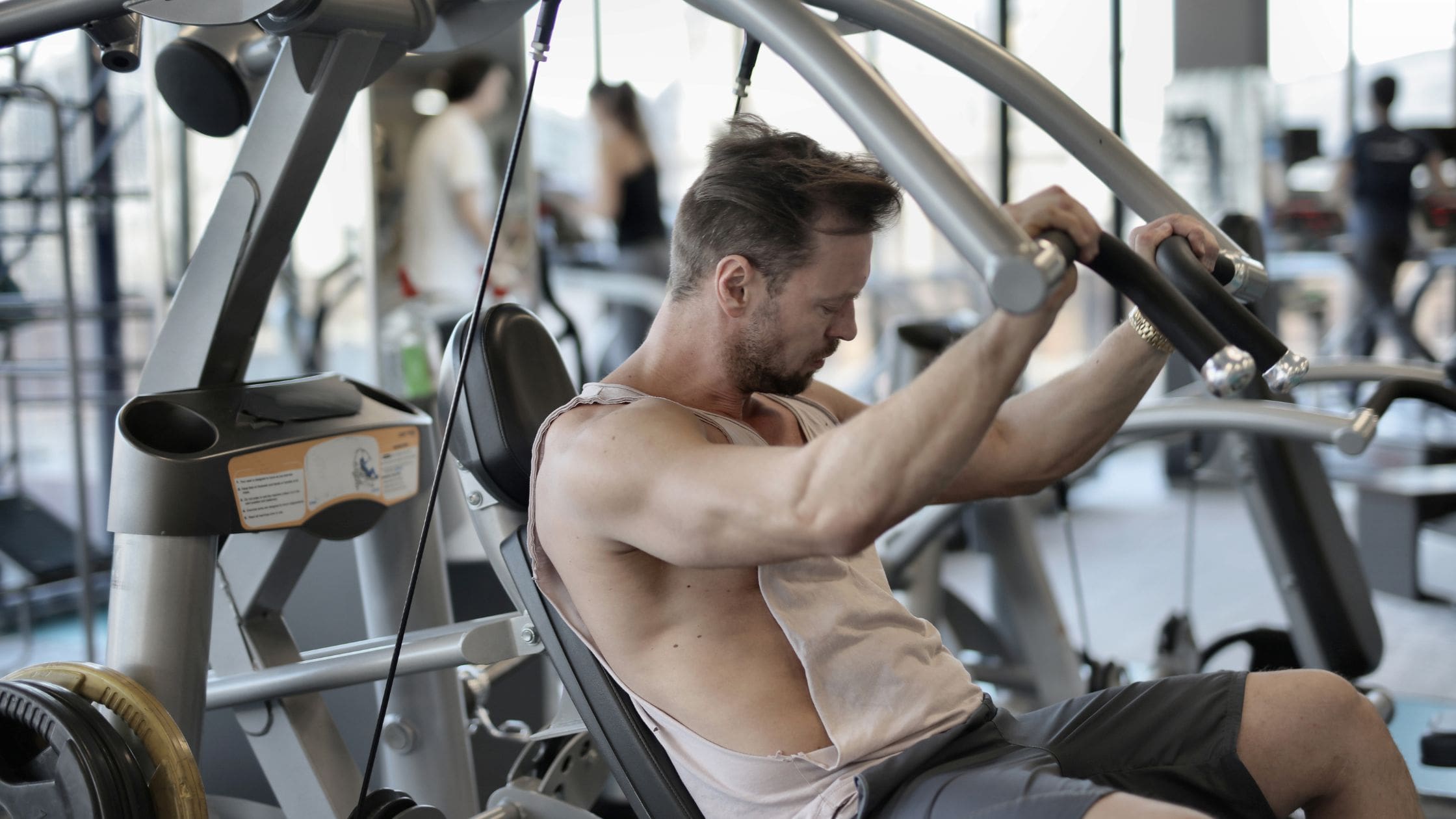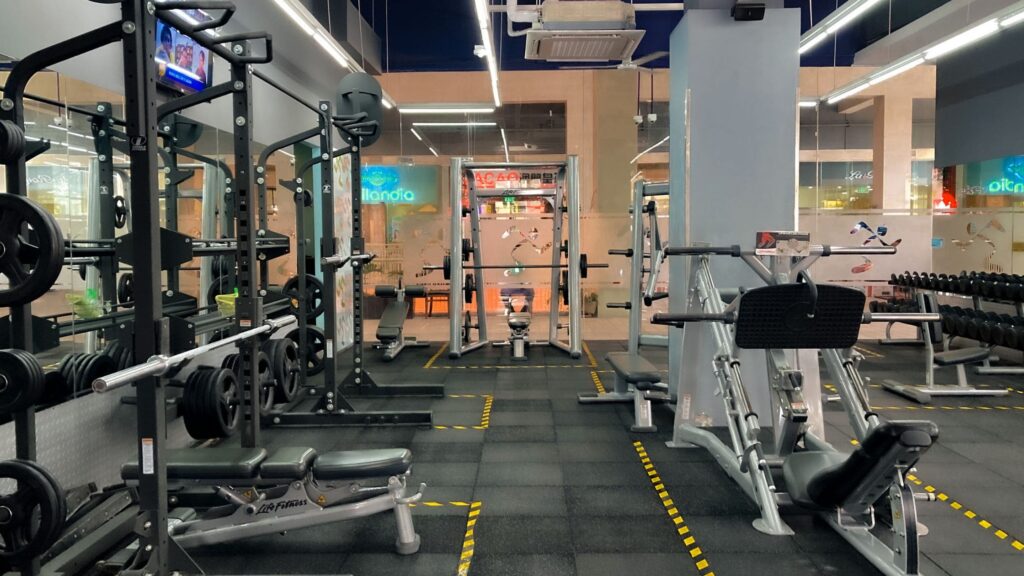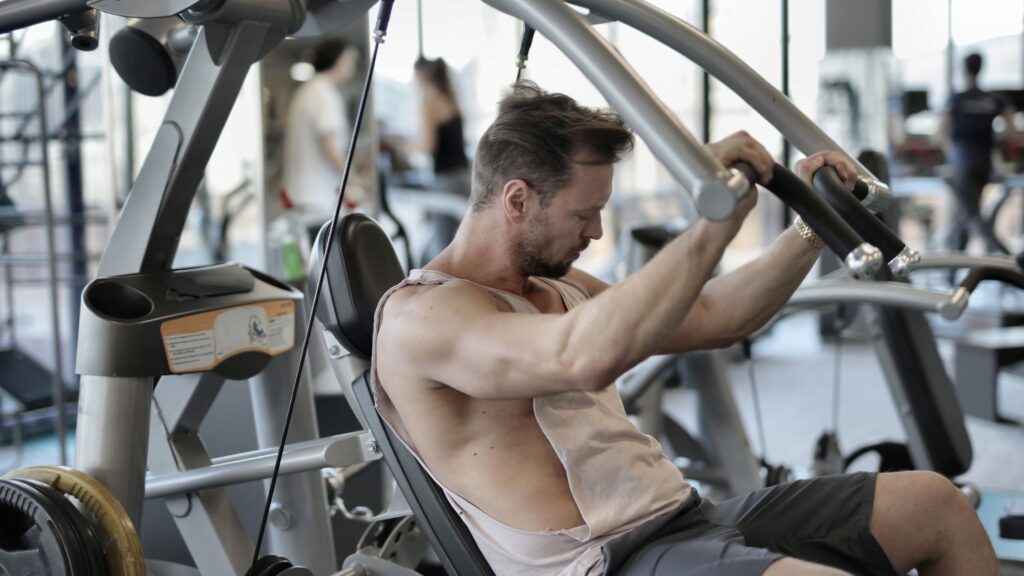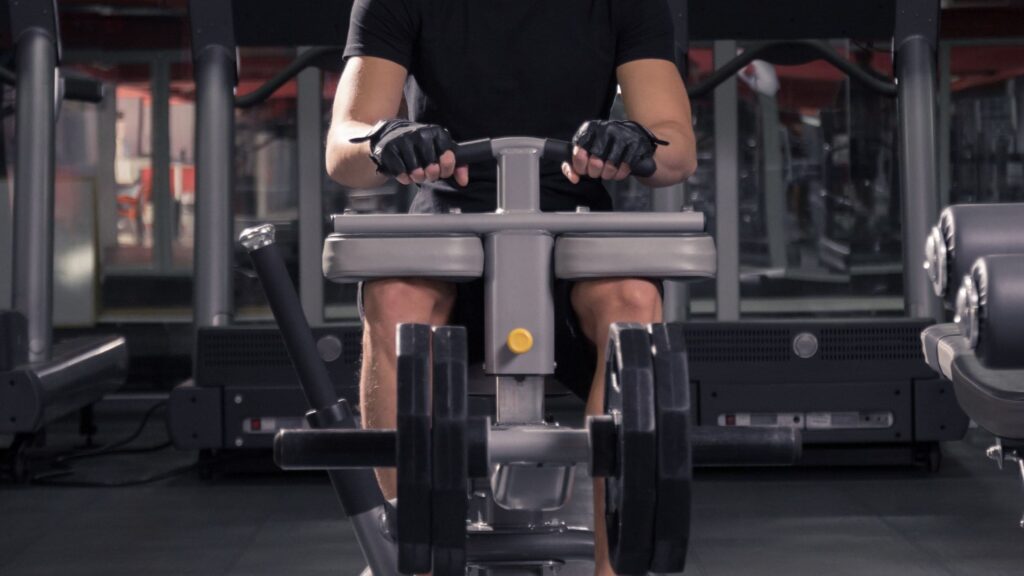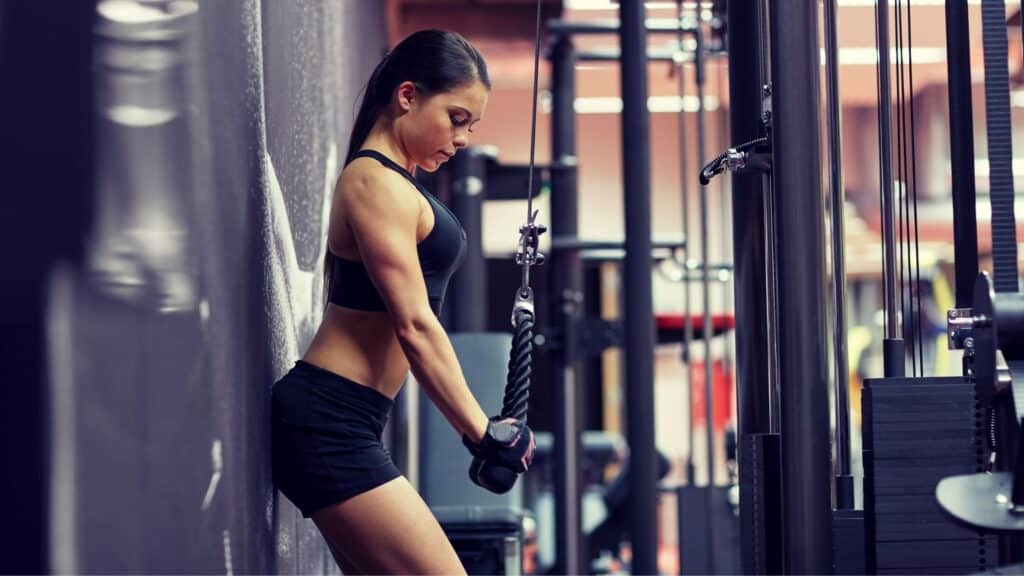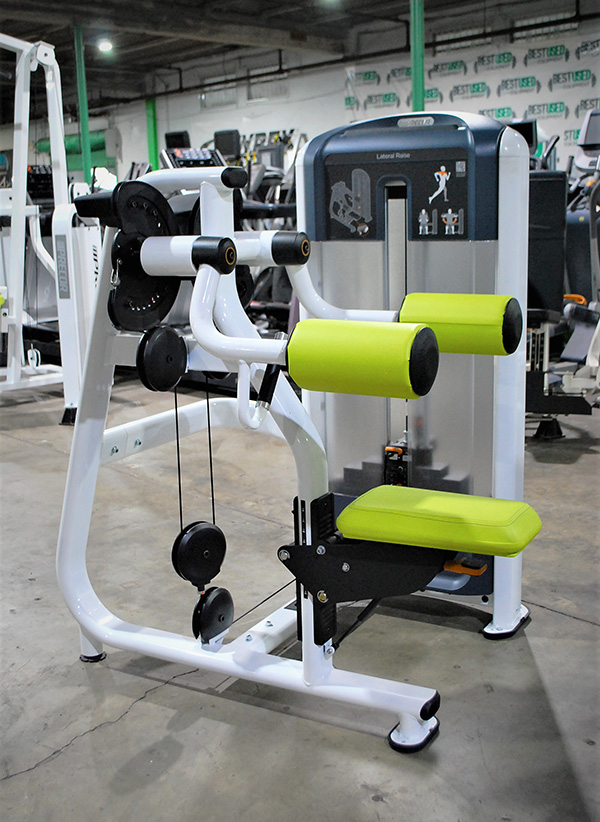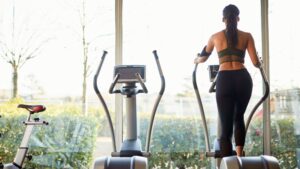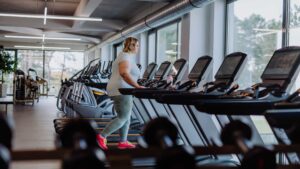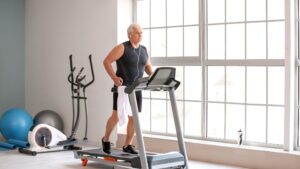Selectorized machines have quietly become the go-to strength equipment in gyms all over the United States. If you’ve ever adjusted a weight stack with a simple pin and jumped straight into a chest press or leg extension, you’ve already used one.
These machines make training feel less intimidating,especially if you’re just starting out, coming back from an injury, or looking for a more controlled workout without loading plates or dealing with complicated setups.
The impact is huge. First introduced back in the 1970s, selectorized strength equipment now makes up around 45% of resistance machines in big commercial gyms.
And the momentum keeps growing—by 2023, 70% of first-time gym members said these machines felt the safest and easiest to use. In fact, over half of all new strength machine installs in 2024 were selectorized units. They’re not just popular, they’re becoming the standard.
And if you’re building a home gym on a budget, used selectorized equipment can be a smart move, just make sure it comes from a reputable supplier with quality checks and warranty support.
In this article, we’ll focus on how selectorized machines work, why they’ve earned a permanent spot in modern gyms, and what you should know before buying one.
What Is the Definition of Selectorized Equipment?
Selectorized equipment are strength-training machines that use an integrated weight stack, typically controlled by a pin or magnetic selector. These machines are designed with safety, adjustability, and ease-of-use in mind. They eliminate the need to manually load or unload weight plates, making the process faster and more accessible—especially for new users.
The key feature that defines selectorized gym equipment is its built-in weight stack. Resistance is selected by inserting a pop-pin or magnetic pin into one of several pre-calibrated plates, usually in 10 lb (≈5 kg) increments.
These machines often feature full or partial enclosures that keep the stack at least 4 inches (10 cm) away from your body during movement, reducing the risk of pinching or crushing injuries.
Commercial-grade cable machines and towers in this category usually carry weight stacks between 150 and 300 lb. Micro-adjustments are possible using 2.5–5 lb magnetic “adder” plates, helping you fine-tune progression.
Each steel plate is threaded on chrome guide-rods, which reduce lateral sway and ensure smooth vertical motion. The selector key, which is often L-shaped and spring-loaded, allows weight selection while seated, typically taking under 2 seconds.
To understand how this type of strength training equipment fits into your gym, it’s important to note the machine’s pulley system. Most selectorized systems use a 2:1 pulley ratio. This means a 200 lb stack provides a working resistance of 100 lb at the handle.
How Do Selectorized Machines Work?
Selectorized machines use a built-in weight stack and a guided movement system to deliver safe, repeatable resistance for strength training.
The core structure includes steel plates aligned on vertical guide rods, which move when resistance is selected using a spring-loaded pin or magnetic selector. The mechanism is designed for smooth motion, quick adjustments, and reduced injury risk.
You simply insert the pin at the plate corresponding to your target load—this can be done in less than three seconds, even from a seated position.
The most common pulley systems follow a 2:1 ratio. This means when you select 100 pounds on the stack, you experience 50 pounds of effective resistance at the handle. Some machines use a 1:1 ratio, where the force applied equals the plate number shown.
Dual-stack functional trainers typically range from 170 to 220 pounds per side, with upgrade kits extending capacity to 300 or 440 pounds in total.
Magnetic selector pins and color-coded plates allow fast switching, which is ideal for supersets or drop sets. Some modern designs let you change resistance without standing, optimizing circuit training. Built-in stacks add 100 to 400 pounds to the frame, which requires that your installation surface supports at least 600 kilograms per square meter.
Routine care is also essential. Dust accumulation on the guide rods is the primary cause of sluggish movement. Monthly cleaning with silicone lubricant reduces friction and preserves smooth operation.
Unlike free weights, selectorized machines offer a fixed path that minimizes stabilizer muscle demand, which is especially useful for beginners, seniors, or rehab patients. The fixed trajectory enforces joint alignment and limits improper technique.
EMG studies show that joint-moment variability is 28 percent lower on selectorized units compared to free-weight alternatives, supporting more consistent form during workouts.
Selectorized systems come in both single-function units and multi-use towers with over 30 cable positions. These machines suit a wide range of users and training goals, from general fitness to targeted hypertrophy.
What is the History and Evolution of Selectorized Equipment?
Selectorized machines first entered the mainstream in 1971 with the launch of the initial commercial pin-stack system. This marked a shift in gym design, offering users a simpler, more intuitive way to train without manually loading external plates.
Over the following decades, selectorized equipment gained a foothold in both public gyms and private training studios.
By the mid-1990s, manufacturers introduced cable-based functional trainers. These models expanded movement variety and introduced multi-joint training options through adjustable cable heights.
The appeal widened further with the release of dual-purpose units that merged standard weight stacks with variable attachment points, improving equipment flexibility.
In recent years, the evolution of selectorized equipment has continued toward space efficiency and smart integration. Rack-mounted side-car systems, which became more common in the 2020s, allow users to fit complete strength units into compact footprints suitable for home or boutique settings.
In 2024, the latest generation of smart stacks began incorporating RFID technology to log user selections and sync with mobile fitness platforms. These innovations mark a transition from analog resistance to connected training systems, enhancing tracking, safety, and overall program design.
What are the Different Types of Selectorized Machines?
The most common types of selectorized machines include upper body machines, lower body machines, core-focused equipment, and specialized hybrid units.
Whether you’re training in a large commercial gym or a compact home gym, understanding these types will help you build a more efficient and targeted strength training routine.
Each machine features integrated weight stacks and allows for quick resistance adjustments. The selection of one
over another often depends on your training goals, available space, and the user population. While some units are single-function, others combine multiple exercises into one frame, maximizing footprint efficiency and equipment versatility. As you review different models, consider how they fit into your current setup and whether they provide the right support, motion range, and customization options to meet your needs.
Upper Body Machines
Upper body selectorized machines are designed to isolate muscles in the chest, shoulders, arms, and upper back. Common examples include the chest press, overhead press, and lat pulldown.
Seated chest fly or pec-deck machines are often used to develop the pectoral muscles with precise motion control. Some machines also include a unilateral converging chest press, allowing you to focus on one side of the body at a time.
For space-conscious facilities, manufacturers often combine the lat pulldown and low row functions into a single tower unit. These dual-purpose machines reduce equipment redundancy without sacrificing training variety. Selectorized chest press machines typically come with a 250 lb weight stack operating on a 1:1 ratio.
In comparison, plate-loaded chest presses can exceed 400 lb, which may be more suitable for power athletes aiming for maximal load progression. When selecting strength equipment, you’ll want to factor in not only resistance levels but also adjustability, footprint, and available attachments.
Lower Body Machines
Selectorized machines for lower body development target the quadriceps, hamstrings, glutes, and calves. The leg press and leg extension machines are staples in most commercial gyms.
More advanced models include the vertical hip thrust machine and selectorized hack-squat, where resistance moves along a pair of guide rods to maintain proper path alignment.
These machines offer seated or supported postures that reduce load on the spine and allow for focused muscle engagement. Selectorized leg press machines usually cap at around 300 lb, which is sufficient for general fitness users and beginners.
However, if you’re an advanced lifter, the resistance limit may fall short. Plate-loaded leg presses offer capacity up to 800 lb, making them more appropriate for power-based programs that require heavy loading.
The design of these machines prioritizes safety and controlled movement, especially for older users or those in rehabilitation. Look for frames with strong weld points, durable rollers, and user-friendly adjustment features to get the most value and longevity out of your equipment investment.
Core and Full-Body Machines
If you’re looking to target multiple muscle groups in one fluid motion, core and full-body selectorized machines offer exceptional versatility. These machines are popular in both commercial gyms and home setups for their ability to support dynamic movement patterns with guided resistance.
One of the most effective examples is the dual-stack cable crossover machine. It allows for up to 32 handle positions, enabling you to perform full-body movements with proper joint alignment. From rotational core exercises to bilateral chest fly movements, the range of options is extensive.
Each side of the crossover typically comes with a 200 lb weight stack, operating on a 2:1 pulley ratio. This means you’re lifting 100 lb of actual resistance per handle, allowing for progressive overload while maintaining form.
For users focused on overall body development, this equipment supports smooth transitions between exercises and promotes stable resistance across a variety of planes and ranges of motion.
Specialized Selectorized Machines
Beyond traditional designs, specialized selectorized machines cater to unique training needs or space constraints. These machines combine multiple functions or offer modular configurations that help you maximize your equipment investment without compromising functionality.
An example is the rack-mounted trainer with selectorized stacks built directly into the frame. These attachments typically include 170 lb stacks per side on a 2:1 ratio, with magnetic pins for fast selection.
Some units support upgrades to 220 lb per side for more advanced training needs.
Hybrid models, such as selectorized cable and Smith machine combos, reduce footprint by up to 25 percent compared to having two separate machines. This kind of integrated system is especially useful in smaller fitness facilities or home gyms with limited space.
You still get the controlled motion of selectorized training, while also benefiting from the barbell guidance of a Smith setup.
What are the Advantages of Selectorized Equipment?
Selectorized equipment offers key advantages in safety, ease of use, and workout efficiency, making it one of the most accessible and effective forms of strength equipment available today.
Its intuitive pin-loaded design eliminates the need to manually move weight plates, allowing for fast adjustments that keep your workout flowing. This system supports consistent movement paths, reduces the need for a spotter, and minimizes joint strain—particularly important for beginners and users recovering from injury.
These machines are designed for broad user groups, from fitness newcomers to older adults and rehabilitation clients.
The fixed motion and guided resistance help maintain form while targeting specific muscle groups.
Many units also include adjustable seats, arm pads, and foot positions to accommodate various body types and strength levels. With clearly marked weight stacks and built-in safety shields, selectorized gym equipment enhances both usability and confidence.
Ease of Use
Selectorized machines are built for simplicity. You adjust the resistance by moving a pin into the weight stack, no plate hauling, no complicated setup. This quick-change mechanism takes less than three seconds and allows you to keep pace during supersets or circuit routines.
It’s especially useful for beginners who may find traditional plate loaded machines intimidating or confusing.
These machines also eliminate guesswork. The weight increments are consistent, usually 10 lb per plate, and often include magnetic adder plates for finer progression. Compared to loading multiple weight plates on a leg press, for example, selectorized strength machines reduce your total setup time by approximately 60%.
This makes your sessions more efficient and keeps your focus on performance instead of logistics. For home gym users and commercial trainers alike, the result is a faster, more structured workout experience.
Safety and Injury Prevention
One of the most valuable aspects of selectorized equipment is its inherent safety. The guided motion and fixed range of movement reduce the likelihood of improper form or overextension.
Since you’re not handling loose weights or relying on a spotter, the risk of dropping heavy equipment or causing a misaligned rep is significantly reduced.
The integrated weight stack prevents you from exceeding the machine’s design limits, which commonly range between 200 and 310 lb depending on the machine type.
Safety shields keep moving parts at a distance from your body, preventing crush injuries or finger pinches. In high-traffic gym environments, these shields also help remove tripping hazards by containing weights within the machine frame.
Selectorized systems are also equipped with secure locking mechanisms. The pop-pin or magnetic selector will not activate unless fully seated, preventing accidental disengagement during use.
These features work together to create a safer workout space—whether you’re in a public gym or training in a home setup with limited supervision.
Customization
Selectorized machines offer precise resistance adjustments that give you full control over training intensity. Unlike plate loaded alternatives, these machines let you fine-tune your workload without physically adding or removing weight plates.
Most models include 2.5 lb adder plates or magnetic micro-plates, allowing you to adjust resistance in small, manageable increments.
This level of precision is especially useful for progression tracking and rehabilitation programs. For example, you can implement a 5 lb offset on dual-stack machines to correct minor strength imbalances between limbs.
This is something athletes and trainers often apply when working on symmetry or recovering from unilateral injuries.
Beyond resistance control, selectorized gym equipment frequently includes settings for seat height, range of motion, and grip position. These built-in adjustments help match the machine to your body type and training focus.
Ideal for Beginners and Older Adults
Selectorized equipment is especially well-suited for people new to strength training, older adults, or anyone returning from injury.
These machines are stable, easy to operate, and offer structured support during each movement. Unlike free weights, which demand balance and coordination, selectorized machines guide your form and keep your motion aligned with biomechanical safety zones.
You can adjust seat height, back-pad angle, and range of motion levers with minimal effort. This makes it easier to set up for exercises like the leg extension or chest press without needing help.
These features are critical when mobility is limited or when you’re unsure how to position yourself properly.
A 2023 survey ranked selectorized equipment as the least intimidating strength option for 70% of first-time gym users in the United States.
That confidence translates into better adherence and quicker skill development, especially in community fitness centers, physical therapy clinics, and beginner-friendly gym environments.
Balanced and Isolated Muscle Training
When your goal is to isolate specific muscle groups and develop symmetrical strength, selectorized strength machines deliver consistent results. Their fixed path design minimizes deviations in motion, which is important for hypertrophy and muscular control.
Unlike some functional systems that allow variable patterns, these machines prioritize form accuracy and range discipline.
Dual-stack machines are particularly helpful for unilateral training. You can perform single-arm pulls or presses using individual stacks, which allows you to correct muscular imbalances between your left and right sides.
This is especially relevant for athletes or rehabilitation patients working to restore symmetry after an injury.
The movement of each stack is governed by rectangular plates riding along guided rails. This setup keeps resistance consistent throughout the entire range of motion, making it easier to apply progressive overload.
For hypertrophy-focused users, this predictability supports focused tension across the targeted muscle without the added variability introduced by free-weight stabilizers.
Supports Proper Form with Fixed Movement Part
Selectorized machines are designed to reinforce proper technique by guiding your body through a pre-set motion path. This mechanical guidance keeps your joints aligned—especially your elbows, wrists, and shoulders—throughout the entire exercise.
That alignment reduces the risk of improper loading and limits shear forces, which can otherwise contribute to joint strain or soft tissue injury over time.
Many selectorized strength machines incorporate built-in cam profiles that adjust resistance to match the natural strength curve of your muscles. For example, as your arm extends during a pressing motion, the cam shape changes the resistance pattern to maintain optimal torque.
This helps ensure that you’re engaging the target muscle groups effectively throughout the full range of motion, rather than just at the start or end of the rep.
Whether you’re using selectorized equipment in a home gym or a commercial facility, this built-in form control makes every workout safer and more efficient, especially for beginners or those returning from injury.
Effective for Circuit Training
Selectorized gym equipment is well suited to circuit-based routines where fast transitions and minimal downtime are essential. Since weight selection is managed by a simple pin or magnetic insert, you can adjust the load in under three seconds and move to the next station without breaking rhythm. This keeps your heart rate elevated and maximizes training density across a short time span.
In structured programs, many gyms follow a 30-second work and 15-second rest interval scheme. The selectorized system supports this format by enabling rapid resistance changes between exercises like leg press, chest press, or lat pulldown without the need for manual plate loading or repositioning.
This feature is especially valuable in group settings or time-constrained workouts where you need efficiency without compromising safety.
You can also implement drop sets with ease. Simply lower the weight stack by 10 or 20 pounds, reinsert the pin, and continue your set—all within five seconds. This allows for metabolic conditioning and hypertrophy strategies within a time-controlled circuit.
Space-Efficient Designs
Selectorized machines provide high function within a compact footprint, making them ideal for gyms with limited floor space or for multipurpose rooms in residential environments.
Dual-stack functional trainers, for example, typically require only 35 square feet yet offer dozens of upper and lower body training options from a single unit. These machines often replace multiple single-joint stations, saving both space and budget.
Unlike plate loaded systems, which demand additional square footage for weight plate trees and clearance around the loading arms, selectorized equipment contains all resistance internally.
Removing external plate storage can free up 4 to 6 square feet in your home gym, allowing you to dedicate more space to stretching, cardio, or accessory work.
This space-saving design doesn’t sacrifice performance. Most machines include multiple cable heights, ergonomic handles, and optional attachments that expand your training possibilities.
Whether you’re optimizing a professional studio layout or building out your garage gym, this level of efficiency ensures you get the most out of every square foot.
What are the Limitations of Selectorized Equipment?
While selectorized equipment offers clear benefits in safety, ease of use, and accessibility, it does have limitations, especially for advanced users and performance-oriented athletes.
The fixed movement path, weight stack limits, and reduced stabilization requirements may not meet the functional needs of lifters seeking dynamic motion or maximal muscle recruitment.
These machines are less effective for activities that demand three-dimensional coordination, balance, or explosive force production.
You may find selectorized machines restrictive if your fitness goals center on athletic development, powerlifting, or sport-specific movement. Although ideal for structured strength training and general conditioning, they are not the best fit for those who need variability in motion or progressive overload beyond standard stack ranges.
Limited Range of Motion
The guided design of selectorized strength machines enforces a fixed range of motion. While this supports form control and consistency, it can limit flexibility in movement patterns, particularly for athletes or individuals engaged in functional training programs.
The movement path is preset by the machine’s frame and pulley configuration, which may not align perfectly with your natural joint trajectory.
For those training in rotational sports or multi-planar environments, selectorized equipment might not offer the variability needed to simulate game-like actions. Functional athletes often require joint angles and ranges that exceed standard machine design by 15–20 percent.
If your routine demands freedom of motion, cable machines or free weights may be more appropriate. These alternatives let you explore compound lifts, asymmetrical loads, and customized positioning, adjustments that are essential for sport-specific programming and neuromuscular development.
Reduced Core Engagement
Selectorized equipment minimizes the need for balance and stabilization, which in turn reduces the engagement of deep core musculature. When you sit on a selectorized leg press or chest press machine, the frame itself absorbs much of the demand that would otherwise be placed on your trunk to maintain position and alignment.
This reduction in stabilizer activation can be seen in electromyographic (EMG) studies, where exercises like the selectorized chest press produce up to 40% lower oblique activation compared to their plate loaded or free-weight counterparts.
For users focusing on total-body strength or postural control, this can be a significant drawback.
That said, this trait also contributes to safety and accessibility—making the equipment ideal for beginners, older adults, or rehabilitation clients.
But if your training goal is to challenge your core dynamically while moving under load, incorporating free weights or instability-based tools into your program may offer more effective results.
Weight Stack Limits
One of the primary drawbacks of selectorized equipment for experienced lifters is the capped resistance found in many machines. Typical upper-body strength machines, such as those used for the chest press or lat pulldown, often top out at 200 pounds on a 1:1 pulley ratio. While this may be sufficient for general fitness or rehabilitation, powerlifters and advanced users can quickly outgrow these limits, especially when training for maximum strength.
Selectorized leg press machines, although built for larger muscle groups, generally max out around 300 pounds. In contrast, plate loaded leg press units can accommodate up to 800 pounds or more, allowing for far greater progression in hypertrophy and strength phases.
For this reason, many high-performance gyms and sports facilities in the United States still rely on plate loaded models for compound movements requiring heavy resistance.
Who Should Use Selectorized Equipment?
Selectorized equipment is particularly well-suited for beginners, older adults, general fitness users, and those recovering from injuries. These machines are designed to be intuitive, offering preset motion paths and adjustable resistance that simplify your workout experience. For someone just starting strength training or returning after a long break, selectorized gym equipment offers a stable and non-intimidating introduction to resistance work.
In rehabilitation settings, trainers and physical therapists rely on selectorized strength machines to control motion and resistance with precision.
Units with seat adjustments, range-of-motion levers, and stack increments as small as 2.5 pounds help you perform safer, more tailored movements. Whether you train in a home gym or a large facility, the built-in safety features and resistance control found in these machines reduce the learning curve.
If your focus is on consistency, form, and safe progression, selectorized strength equipment provides a solid foundation for long-term results across all major muscle groups.
Are Selectorized Machines Good for Advanced Lifters?
Yes, selectorized machines can benefit advanced lifters, especially during hypertrophy-focused routines. If you’re programming drop sets or pre-exhaust phases, the ability to change weights in under three seconds using a pop-pin or magnetic selector can enhance your training efficiency. These features support fast-paced, high-volume protocols that target muscle fatigue.
While plate loaded machines still dominate when it comes to maximum load capacity, selectorized units are often used for blood-flow restriction sets or high-rep metabolic work.
Lifters focused on muscular endurance or symmetry may prefer selectorized chest presses, cable machines, or leg extension stations for their controlled resistance path and consistent tension throughout the movement.
If your goal includes focused muscle development, smooth weight changes, and joint safety, without always loading 400+ pounds, then selectorized gym equipment has a place in your workout series.
Who Should Not Use Selectorized Equipment?
While selectorized equipment offers consistency and ease of use, it may not be ideal for everyone, especially if your training goals require explosive movement, unrestricted motion paths, or extreme loading.
Olympic weightlifters, for example, depend on dynamic triple-extension exercises that can’t be replicated on fixed-path machines.
Similarly, functional athletes who prioritize full-body stabilization often choose free weights or cable machines that allow more freedom and proprioceptive engagement.
Powerlifters and strongman competitors may also find selectorized strength equipment limiting due to resistance ceilings.
Most upper-body stacks max out around 200 pounds, and even high-end leg press machines with selectorized systems rarely exceed 300 pounds.
Plate loaded options offer significantly more capacity for building absolute strength.
If your goal includes training at near-maximal intensities or replicating sport-specific movements with a barbell, selectorized gym equipment may not meet your performance standards. In those cases, free weights or hybrid systems provide better long-term value and functional versatility.
How Does Selectorized Equipment Compare to Plate Loaded Machines?
While selectorized systems use fixed weight stacks adjustable via a pin, plate-loaded machines require you to manually add and remove weight plates. This difference influences nearly every aspect of the training experience—from ease of use and adjustability to safety and workout speed.
Selectorized gym equipment is ideal for high-volume, low-hassle training, especially in a home gym or commercial fitness facility where time and space are limited. On the other hand, a plate-loaded strength machine offers higher loading potential, making them better suited for advanced lifters aiming to develop maximal strength. Each system has its own benefits and drawbacks, depending on your training goals, space, and budget.
To help you decide which option suits your needs, here’s a direct comparison across ten critical training and performance factors:
| Feature | Selectorized Equipment | Plate Loaded Machines |
| Resistance System | Pin-selected weight stacks | Manually loaded weight plates |
| Ease of Use | Fast pin changes (≤3 sec) | Manual loading takes more time |
| Adjustability | 10 lb steps (some with micro adders) | Fully adjustable via any plate combo |
| Safety | Enclosed stacks, no dropped plates | Risk of dropped plates or imbalance |
| Footprint | Compact, integrated design | Requires extra space for plate storage |
| Weight Capacity | Typically up to 300 lb per station | 600–1,000 lb+ capacity on many models |
| Training Style | Ideal for circuits, rehab, and drop sets | Best for strength building and max loading |
| Cost | Higher upfront; less maintenance | Varies widely by brand and plate type |
| User Type | Beginners, seniors, general fitness users | Powerlifters, strongmen, advanced athletes |
| Versatility | Fixed path; good for muscle isolation | Greater range of motion and training variation |
Ease of Use
With selectorized equipment, you can switch resistance with a simple pin adjustment, usually in under three seconds. This makes selectorized units ideal for drop sets, supersets, or fast-paced circuit training. There’s no need to handle bulky weight plates or worry about symmetry since the load is evenly distributed within the stack.
With plate-loaded gym equipment, you’re manually adding and removing weight plates, which takes time and space.
For example, loading five 45-pound plates per side on a leg press adds nearly a minute of setup time. It can interrupt workout flow, especially in shared gym environments where multiple users cycle through.
Selectorized systems also eliminate the need for external plate trees or storage racks, reducing gym clutter and trip hazards. If your goal is to keep workouts streamlined and distraction-free, this style of equipment offers a clear advantage in daily training efficiency.
Adjustability
When comparing adjustability, both systems offer unique advantages depending on your training precision and goals. Selectorized machines generally move in 10-pound increments, though some models offer magnetic micro plates for 2.5–5 lb changes.
This supports fast, intuitive weight adjustments without having to stand up or interrupt your rhythm.
Plate-loaded machines, on the other hand, give you total control over resistance. You can fine-tune your setup using fractional weight plates and even create uneven loading. This is useful if you’re correcting muscular imbalances—like adding 5 lb more on your dominant arm during a unilateral press.
That level of asymmetrical precision isn’t possible on most selectorized models unless you’re using dual-stack cable machines.
So if you value easy, consistent load changes for circuit or rehab use, selectorized strength equipment is hard to beat. But if your training needs include advanced programming, asymmetry correction, or ultra-light progressions, plate-loaded options may offer the flexibility you need.
Safety
Selectorized equipment is often favored for its built-in safety features. Each machine includes an integrated weight stack enclosed in a steel frame, keeping loose plates off the floor. This design reduces trip hazards in busy gym environments and eliminates the need for external storage. Pin-based systems also ensure resistance can’t shift or drop mid-set, as long as the selector pin is properly inserted.
Plate-loaded gym equipment requires more user oversight. You need to load and unload weight plates manually, often lifting multiple 45 lb units per side.
Without collars, these plates can slide off during motion, posing a risk, especially on vertical movements like the leg press. Improper seating of plates or imbalance can destabilize the load, leading to injury.
Weight Capacity
Selectorized machines have fixed resistance limits determined by cable tension, pulley ratios, and frame load capacity.
Most upper-body selectorized strength equipment maxes out between 150–250 lb, while selectorized leg press machines usually cap around 300 lb. These units meet the demands of general users and many fitness goals, but advanced lifters may find the ceiling too low for progression.
In contrast, plate-loaded gym equipment can scale to extreme weights—especially in lower-body exercises. For instance, a commercial-grade plate-loaded leg press can often support over 800 lb per side.
Lifters focused on maximal strength development benefit from the open-ended potential of weight plates. If you’re training for powerlifting, strongman, or Olympic weightlifting, the ability to load beyond 500 lb per movement is essential—and only plate-loaded systems offer that level of freedom.
Maintenance Requirements
Maintenance routines differ significantly between selectorized and plate-loaded machines, impacting long-term performance and budget. Selectorized equipment includes cables, pulleys, guide rods, and selector pins—each requiring inspection every 6 months.
Cables may fray over time and pulleys must remain lubricated to ensure smooth motion. Dust on guide rods can lead to resistance inconsistency unless wiped with silicone spray.
Plate-loaded machines, by contrast, contain fewer moving parts. Most rely on bearings and lever arms, which need annual greasing but involve less frequent component checks. Their open-frame design also makes cleaning easier.
Although selectorized machines often come with a higher upfront price, their self-contained system reduces the need for external attachments or weight plate purchases.
Space and Footprint
Selectorized equipment tends to take up more overall floor space, especially when you’re using multiple single-function machines.
Each selectorized unit includes an integrated frame and enclosed weight stack, which can increase volume by around 20% compared to a basic plate-loaded equivalent.
However, that same design removes the need for separate weight plate storage, which can reclaim 4–6 square feet in your home gym or commercial studio.
Plate-loaded gym equipment is more compact in isolation, but it requires access to a shared plate tree or storage rack. If you’re running several stations simultaneously, the plates must be shuffled between machines, causing clutter and increasing setup time.
For users who prioritize a clean training path and minimal setup movement, selectorized strength equipment may be more efficient despite its larger footprint.
Cost
Selectorized gym equipment typically ranges between $3,500–$5,000 per unit due to the built-in steel weight stacks (often 100–400 lb), higher gauge steel frames, and more complex pulley and cable systems.
The added manufacturing and safety mechanisms raise the price, especially for commercial-grade selectorized strength machines.
On the other hand, plate-loaded machines such as leg presses or chest presses usually cost between $1,200–$2,000. You’ll need to factor in the price of weight plates separately, which can add another few hundred dollars. Still, plate-loaded options offer excellent performance for strength training at a lower upfront cost. If you’re outfitting a budget-conscious facility or building a starter home gym, the plate-loaded path offers more flexibility in your initial investment.
Muscle Engagement and Feel
Selectorized equipment delivers a consistent resistance curve across the full range of motion. The cable system and cam profiles are calibrated to follow the natural strength curve of joints, providing smooth resistance that’s excellent for hypertrophy and rehab-focused training. This system keeps your movement path stable and reduces compensatory strain.
Plate-loaded machines, on the other hand, offer a different kind of feedback. The free-moving lever arms demand more from your stabilizer muscle groups, particularly around the shoulders, hips, and trunk. This results in greater core engagement and variation in resistance based on movement angle and bar path. While not ideal for beginners, this variability is often preferred by experienced lifters looking for a more organic, barbell-like training feel.
Versatility of Exercises
Plate-loaded gym equipment often offers bilateral and unilateral lever arms, allowing you to train each side of your body independently. This makes them ideal for addressing muscle imbalances or performing strength-specific variations like single-leg presses or one-arm rows.
Selectorized machines shine in the cable-based category, where multi-angle motion and dual-handle designs open up hundreds of movement patterns. You can train in both vertical and horizontal planes, including rotational and diagonal movements—especially valuable in functional fitness and rehab.
For example, a dual-stack cable crossover offers 32 adjustable handle positions, which supports full-body routines from chest flys to woodchoppers. If you’re building a compact home gym or planning circuits, selectorized cable machines provide greater training diversity without swapping attachments or plates.
Learning Curve and Skill Development
Learning to use selectorized gym equipment is generally easier than mastering plate-loaded machines. Because selectorized strength machines guide your path of motion, you won’t need to stabilize the frame or balance the load.
This makes the system especially friendly for beginners, older adults, or users with limited mobility. The pre-set range of motion helps you focus on technique while minimizing injury risk.
On the other hand, plate-loaded strength equipment demands more from your proprioception—your body’s awareness of position and balance. Every repetition on a plate-loaded chest press or leg press engages stabilizers to keep the path steady. That challenge is valuable for skill development, but it can be a barrier for new lifters. If you’re looking to build foundational motor control and refine your form, plate-loaded units offer greater feedback.
How Much Does Selectorized Equipment Cost?
For personal use, single-stack units generally range from $900 to $1,800. Dual-stack functional trainers used for broader muscle group coverage usually cost between $2,500 and $3,200.
Commercial selectorized machines, which are built for higher-volume use and durability, often run from $3,500 to $5,000 per unit.
You should also factor in ongoing costs. Heavy-use machines may require a cable replacement every two to three years, typically around $75. Compared to plate-loaded machines, selectorized systems are more expensive upfront, but they don’t require additional weight plates or storage. If you don’t already own plates, expect to pay another $1,000 to $1,500 for a full set.
What are Common Mistakes When Using Selectorized Equipment?
Using selectorized machines efficiently requires attention to both setup and technique. Below are some frequent mistakes and how to avoid them:
- Forgetting to engage the safety pin fully. If the selector pin isn’t locked in, the stack can misalign or fail to lift smoothly. Always double-check pin placement before starting.
- Adjusting the weight before setting the seat height or back pad angle. This can lead to compromised form or limited range of motion. Adjust your position first, then load the weight.
- Performing only partial reps because of incorrect setup. Improper positioning can block full movement, especially during chest or shoulder exercises. Test range before each set.
- Allowing the stack to slam. Dropping the weight at the end of a rep stresses cables and pulleys, shortening their lifespan. Control the descent to prevent premature wear.
- Choosing a heavier load because the stack “looks lighter.” Selectorized stacks often use pulley systems that reduce actual resistance. Always warm up and test your ability before pushing limits.
- Skipping monthly cleaning of the guide rods. Dust buildup creates friction, which can lead to cable wear and erratic motion. Wipe rods and lubricate regularly.
What are Some Common Problems and Defects in Selectorized Equipment?
Even well-designed selectorized machines can develop mechanical issues over time. Here are the most common problems, what causes them, and how to fix them:
- Frayed cables: Often occur after about 50,000 usage cycles. Replace cables immediately to prevent failure during use.
- Sticky guide rods: Caused by dust or lack of lubrication. Clean rods monthly with a cloth and apply silicone spray to maintain smooth motion.
- Loose selector rod: Misalignment during weight changes can result from a loose selector bolt. Tighten it to the recommended torque setting, typically around 8 Nm.
- Cracked pulleys: Nylon pulleys can degrade from age or heavy use. Swap them out with original parts to maintain performance and rated resistance.
- Worn pop-pin springs: These springs lose tension over time, making seat or arm adjustments unreliable. Inspect the pop-pin annually and replace if it no longer holds securely.
- Faded or missing weight stack labels: This can make selecting the correct weight difficult and lead to loading errors. Replace labels as needed to preserve clarity and safe use.
How Does Selectorized Equipment Compare to Free Weights?
Free weights prioritize full-body stabilization and joint control, engaging more muscle groups and motor units in each movement. In contrast, selectorized strength machines guide your range of motion, making them ideal when your focus is on isolation, muscle endurance, or recovery.
You’ll find selectorized equipment easier to use when you’re short on time or targeting specific muscles with high-rep drop sets. The guided path enhances safety by reducing form-related errors, which is especially beneficial for beginners.
However, free weights generally activate 30–40% more stabilizer muscles, which is essential for athletic performance and advanced strength training. For functional carryover and compound coordination, barbell movements often offer more value.
In short, selectorized machines simplify movement and minimize injury risk, while free weights demand more control and deliver broader performance benefits.
Selectorized Machines in Commercial vs Home Gyms
In commercial gyms, selectorized strength equipment is a staple for efficient member flow, quick workouts, and consistent performance. Gym staff favor it because it reduces injury risk and supports trainer-led circuits. Weight stacks are protected and intuitive to adjust, making selectorized units especially useful during peak hours.
For home gyms, space and budget often dictate the decision. A commercial-grade selectorized leg press or lat pulldown can be bulky and costly to move.
Many home users opt for wall-mounted cable machines or selectorized multi-units that fit into compact spaces—usually 30 to 35 square feet. These units provide a balance of resistance and functionality without the need to store extra weight plates.
Plate-loaded machines are often more affordable for residential setups. If you already own barbells and plates, a plate-loaded chest press or leg extension offers strong value. But selectorized machines excel in ease of use and fast resistance changes, making them perfect for time-sensitive, structured workouts.
How to Choose the Right Selectorized Equipment?
Finding the right selectorized gym equipment means matching machine specifications to your goals, space, and user profile.
Whether you’re equipping a commercial facility or building your home gym, you want versatile, durable, and user-friendly strength machines that meet your needs today and in the future.
Here’s a checklist to guide your decision:
- Weight stack range: Look for a minimum of 200 lb for general use, and 300 lb for leg press or chest press machines used by advanced lifters.
- Weight increment: Machines with 10 lb steps allow smoother progressions. Dual-stack systems offer more options for bilateral and unilateral training.
- Pulley system: Opt for aluminum pulleys and sealed bearings for reduced friction and extended lifespan.
- Resistance ratio: Understand 1:1 vs 2:1. Functional trainers often use 2:1, where 100 lb on the stack gives 50 lb resistance.
- Warranty: Aim for at least 3 years on cables and pulleys to avoid surprise repair costs.
- Ergonomics: Check if the seat, backrest, and roller adjustments allow precise alignment for different body types.
- Door clearance: If installing in a basement or narrow space, measure the frame depth; many selectorized towers won’t fit through sub-32 in doorways.
Consider used selectorized strength equipment if you’re budget-conscious. Many refurbished machines from brands like Life Fitness, Cybex, and Body Masters deliver commercial-grade performance at a lower price.
Make sure used units come with a recent inspection and tested cable integrity.
Finally, always partner with a reliable gym equipment supplier. Best Used Gym Equipment (BUGE) offers a curated selection of refurbished selectorized gym equipment from top-tier brands. Whether you’re ordering a single machine or outfitting an entire facility, BUGE ensures every unit is professionally rebuilt, safety-tested, and performance-ready.
What is the Maintenance Requirement and Longevity of Selectorized Machines?
Selectorized gym equipment is engineered for long-term use, but maintaining performance and safety requires routine servicing.
Most selectorized strength machines use high-tensile steel cables rated to withstand over 2,000 pounds. These cables should be replaced approximately every three years or after around 50,000 usage cycles to avoid unexpected failures.
Regular wear points include cable fraying, pulley bearings, guide-rod buildup, and selector pins.
To extend equipment life, set up a monthly inspection log.
You should check for bearing noise in the pulley system, tighten all frame hardware, and clean the guide rods using a silicone-based lubricant to ensure smooth resistance.
Selectorized machines benefit from semi-annual pulley alignment checks to maintain load consistency through the full range of motion.
This differs from plate-loaded units, which primarily require bolt torque checks and occasional lubrication.
When used correctly and maintained consistently, selectorized equipment can deliver over a decade of reliable function in both commercial gyms and home setups across the United States.
How is Selectorized Machines Integrated in Fitness Programs?
Selectorized equipment simplify strength training by guiding your movement path, letting you focus entirely on muscle contraction.
They’re ideal in workout programs that emphasize efficiency, safety, and muscle isolation. You’ll often find selectorized strength equipment programmed into circuit training, hypertrophy regimens, or high-volume sets like drop sets.
Common selectorized machine exercises include the lat pulldown, leg press, seated chest press, and leg extension. These machines are particularly beneficial in commercial gyms where multiple users require consistent, repeatable results.
In home gym setups, users often opt for compact functional trainers or cable machines that combine several movements in a single footprint. This allows for targeting major muscle groups without rearranging plates between each set or exercise.
Selectorized Machines in Rehabilitation Settings
In clinical environments and rehab programs, selectorized machines offer unparalleled control over resistance, movement range, and progression. This level of precision is critical when recovering from injuries or surgeries.
Machines like the selectorized leg extension are favored for their ability to isolate specific muscle groups while eliminating unpredictable joint loading.
For example, physical therapists often program 2.5-pound resistance increments to slowly rebuild muscle without overloading healing tissue.
Range-of-motion stops on selectorized equipment also help prevent re-injury by restricting extension or flexion at vulnerable joints. Since the motion path is pre-defined by the machine’s cam and cable system, there’s minimal risk of compensation from surrounding muscles.
This feature is especially useful when working with elderly patients or those in post-operative stages who need repeatable, safe movement patterns.
Combining Selectorized and Free Weight Training
Blending selectorized and free weight exercises creates a balanced approach to strength training. You get the stabilizer engagement and compound movement benefits of free weights, while also leveraging the safety, convenience, and isolation features of selectorized machines. This combination supports both foundational strength and targeted hypertrophy.
A practical method is to start with a barbell-based compound lift such as squats or bench press to develop total-body coordination and core strength. Then, transition to a selectorized machine to isolate the fatigued muscle group.
For instance, you might follow a plate-loaded leg press with a selectorized leg extension to fully exhaust the quads.
Supersets like barbell row followed by a cable machine pulldown can amplify training volume without compromising form. This approach works well whether you’re in a home gym or commercial facility. It lets you load the muscles heavily while minimizing injury risk and ensuring maximum time under tension, an essential factor in muscle growth.
Machine Size, Mobility, and Installation Considerations
Selectorized strength machines often include integrated weight stacks ranging from 100 to 400 lb, significantly increasing their total frame weight.
This added mass enhances stability during training but makes relocation more complex. If you’re moving it into a home gym or basement, plan for either a two-person move or partial disassembly to avoid damage to the unit, or your walls.
In contrast, plate-loaded gym equipment tends to be lighter and narrower. These units can be maneuvered through standard door frames and around corners more easily.
That’s a key reason why many home gym users in the United States prefer plate-loaded systems, especially when stairs or tight hallways are involved.
Selectorized equipment also requires specific flooring support.
Commercial facilities should confirm floor capacity meets or exceeds 600 kg/m², especially when installing leg press towers or multi-stack machines.
For home gyms, 12 mm rubber tiles help distribute point loads and reduce frame vibration.
Shipping and setup should not be overlooked. Freight delivery is often required for selectorized gym equipment, which can complicate logistics for multi-storey buildings without elevators. Plate-loaded models, while simpler to deliver and set up, still need proper positioning and anchoring.
Conclusion
At the end of the day, selectorized machines make strength training easier, safer, and way more approachable, especially if you’re just starting out or want a no-fuss workout.
The built-in weight stacks mean you don’t have to mess with plates or worry about dropping anything on your foot. You just pull the pin, choose your resistance, and go.
But let’s be real, if you’re chasing big numbers or training like a powerlifter, you’ll probably need something heavier.
Most selectorized units max out around 200 to 300 pounds, which works great for most people, but not for heavy lifters looking to push serious weight.
So how do you pick the right gear? Simple, look at your goals, your space, and your budget. Whether you’re setting up your dream home gym or upgrading a commercial space, what matters most is finding equipment that fits your needs today and grows with you tomorrow.
We all want results, and the right setup makes all the difference.
Frequently Asked Questions
1. Can Selectorized Machines Build as Much Muscle as Free Weights?
Yes, selectorized machines can absolutely build as much muscle as free weights when programmed properly. They provide consistent resistance, isolate specific muscle groups, and allow drop sets or high-rep burnout training. While free weights engage more stabilizers, selectorized gym equipment supports muscle hypertrophy with controlled form and reduced injury risk, especially in structured strength training programs.
2. Do All Selectorized Machines Use Weight Stacks?
No, not all selectorized machines use weight stacks, though most do. Some advanced selectorized units now feature magnetic or hydraulic resistance systems in place of traditional weight plates. However, the vast majority of selectorized strength equipment still relies on cable machines and pinned weight stacks. These stacks offer fast resistance changes, space efficiency, and safer operation in busy gym or home fitness environments.


